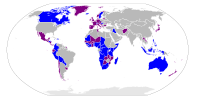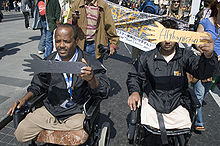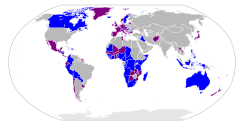- Convention on Cluster Munitions
-
Convention on Cluster Munitions 
Signatories to the Convention (blue) and States Parties (purple) Type Disarmament Drafted 19–30 May 2008 in Dublin Signed 3 December 2008 Location Oslo Effective 1 August 2010[1] Condition 6 months after 30 ratifications[2] Signatories 108[3] Parties 63[3] Depositary UN Secretary-General[4] Languages Arabic, Chinese, English, French, Russian and Spanish[5]  Convention on Cluster Munitions at Wikisource
Convention on Cluster Munitions at WikisourceThe Convention on Cluster Munitions (CCM) is an international treaty that prohibits the use, transfer and stockpile of cluster bombs, a type of explosive weapon which scatters submunitions ("bomblets") over an area. The convention was adopted on 30 May 2008 in Dublin,[6] and was opened for signature on 3 December 2008 in Oslo. It entered into force on 1 August 2010, six months after it was ratified by 30 states.[2] Currently, 63 states have ratified it and another 47 have signed but not ratified it.[3]
Countries that ratify the convention will be obliged "never under any circumstances to"[7]:
(a) Use cluster munitions;
(b) Develop, produce, otherwise acquire, stockpile, retain or transfer to anyone, directly or indirectly, cluster munitions;
(c) Assist, encourage or induce anyone to engage in any activity prohibited to a State Party under this Convention.The treaty allows certain types of weapons with submunitions that do not have the indiscriminate area effects or pose the same unexploded ordnance risks as cluster munitions. Permitted weapons must contain less than ten submunitions, and each must weigh more than 4 kilograms (8.8 lb), and each submunition must have the capability to detect and engage a single target object and contain electronic self-destruct and self-deactivation mechanisms.[8] Weapons containing submunitions which all individually weigh at least 20 kg (44 lb) are also excluded.[9] A limited number of prohibited weapons and submunitions can be acquired and kept for training in, and development of, detection, clearance and destruction techniques and counter-measures.
Contents
History
The impetus for the treaty, like that of the 1997 Ottawa Treaty to ban landmines, has been concern over the severe damage and risks to civilians from explosive weapons during and long after attacks. A varying proportion of submunitions dispersed by cluster bombs fail to explode on impact and can lie unexploded for years until disturbed. The sometimes brightly colored munitions are not camouflaged, but have been compared to toys or Easter eggs, attracting children at play.[10][11] Human rights activists claim that one in four casualties resulting from submunitions that fail to explode on impact are children who often pick up and play with the explosive canisters well after the conflict has ended.[12] The 2006 Lebanon War provided momentum for the campaign to ban cluster bombs. The United Nations estimated that up to 40% of Israeli cluster bomblets failed to explode on impact.[13] Norway organized the independent Oslo process after discussions at the traditional disarmament forum in Geneva fell through in November 2006.[14]
The cluster munitions ban process, also known as the Oslo Process, began in February 2007 in Oslo. At this time, 46 nations issued the "Oslo Declaration", committing themselves to:
Conclude by 2008 a legally binding international instrument that prohibits the use and stockpiling of cluster munitions that cause unacceptable harm to civilians and secure adequate provision of care and rehabilitation to survivors and clearance of contaminated areas.[15][16]
The Oslo Process held meetings in Lima in May 2007 and Vienna in December 2007. In February 2008, 79 countries adopted the "Wellington Declaration", setting forth the principles to be included in the convention.[17]
Adoption of the convention
Delegates from 107 nations agreed to the final draft of the treaty at the end of a ten-day meeting held in May 2008 in Dublin, Ireland.[18] Its text was formally adopted on 30 May 2008 by 107 nations,[19] including 7 of the 14 countries that have used cluster bombs and 17 of the 34 countries that have produced them.[20]
The treaty was opposed by a number of countries that produce or stockpile significant quantities of cluster munitions, including China, Russia, the United States, India, Israel, Pakistan and Brazil.[12] The U.S. has acknowledged humanitarian concerns about the use of cluster munitions, but insisted that the proper venue for a discussion of cluster munitions was the forum attached to the Convention on Certain Conventional Weapons, which includes all major military powers.[21] The U.S. has further stated that the development and introduction of "smart" cluster munitions, where each submunition contains its own targeting and guidance system as well as an auto-self-destruct mechanism, means that the problematic munitions are being moved away from in any case.[12] In 2006, Barack Obama voted to support a legislative measure to limit use of the bombs, while his general election opponent John McCain and his primary opponent Hillary Clinton (now U.S. Secretary of State) both voted against it.[22] According to the Pentagon’s 2008 policy, cluster munitions are actually humane weapons. “Because future adversaries will likely use civilian shields for military targets – for example by locating a military target on the roof of an occupied building – use of unitary weapons could result in more civilian casualties and damage than cluster munitions,” the policy claims. “Blanket elimination of cluster munitions is therefore unacceptable due not only to negative military consequences but also due to potential negative consequences for civilians.” [23]
The treaty allows certain types of weapons with submunitions that do not have the indiscriminate area effects or pose the same unexploded ordnance risks as the prohibited weapons. These must contain no more than nine submunitions, and no submunition may weigh less than 4 kilograms (8.8 lb). Each submunition must have the capability to detect and engage a single target object and contain electronic self-destruct and self-deactivation devices.[8] Weapons containing submunitions which each weigh at least 20 kg (44 lb) are also excluded.[9] Australia, which supports the treaty, stated that the convention does not prohibit the SMArt 155 artillery shell that it has bought, which releases two self-guided self-destructing submunitions.[8]
In response to U.S. lobbying, and also concerns raised by diplomats from Australia, Canada, Japan, the United Kingdom and others, the treaty includes a provision allowing signatory nations to cooperate militarily with non-signatory nations. This provision is designed to provide legal protections to the military personnel of signatory nations engaged in military operations with the U.S. or other non-signatory nations that might use cluster munitions.[24] David Miliband, who was Britain's foreign secretary under Labour, approved the use of a loophole to manoeuvre around the ban and allow the US to keep the munitions on British territory.[25]
Prior to the Dublin meeting, the United Kingdom was thought to be one of a group of nations in a pivotal role whereby their cooperation could make or break the treaty. In a dramatic[peacock term] turn of events shortly before the end of the conference, Prime Minister Gordon Brown declared that the U.K. would withdraw all of its cluster bombs from service.[26] This was done despite intense behind-the-scenes lobbying by the U.S. and objections by British government personnel who saw utility in the weapons.
The CCM was opened for signature at a ceremony at Oslo City Hall on 3–4 December 2008. By the end of the ceremony, 94 states had signed the treaty, including four (Ireland, the Holy See, Sierra Leone and Norway) which had also submitted their instruments of ratification. Signatories included 21 of the 27 member-states of the European Union and 18 of the 26 countries in NATO. Among the signatories were several states affected by cluster munitions, including Laos and Lebanon.
In November 2008, ahead of the signing Conference in Oslo, the European Parliament passed a resolution calling on all European Union governments to sign and ratify the Convention, as several EU countries had not yet declared their intention to do so.[27] Finland had declared it would not sign.[28]
Entry into force
According to article 17 of the treaty, the convention entered into force "on the first day of the sixth month after the month in which the thirtieth instrument of ratification, acceptance, approval or accession has been deposited"[3]. Since the thirtieth ratification was deposited during February 2010, the convention entered into force on 1 August 2010; by that point, 38 nations had ratified the treaty.
As the convention entered into force, UN Secretary-General Ban Ki-moon spoke of "not only the world's collective revulsion at these abhorrent weapons, but also the power of collaboration among governments, civil society and the United Nations to change attitudes and policies on a threat faced by all humankind".[29] A spokesman for the International Committee of the Red Cross said "These weapons are a relic of the Cold War. They are a legacy that has to be eliminated because they increasingly won't work".[30] Nobel peace prize winner Jody Williams called the convention "the most important disarmament and humanitarian convention in over a decade".[30]
Anti-cluster munitions campaigners praised the rapid progress made in the adoption of the convention, and expressed hope that even non-signatories – such as the US, China and Russia – would be discouraged from using the weapons by the entry into force of the convention.[31] As one of the countries that did not ratify the treaty, the United States said that cluster bombs are a legal form of weapon, and that they had a "clear military utility in combat." It also said that compared to other types of weapons, cluster bombs are less harmful to civilians.[29]
Article 11 requires the first Meeting of States Parties to be held within 12 months of the entry into force. The first such meeting was held in Laos in November 2010.[32]
States Parties
As of 18 September 2011 there are 63 States Parties to the Convention.
State Party Signed Ratified or acceded Entered into force  Afghanistan
Afghanistan3 December 2008 9 September 2011 1 March 2012  Albania
Albania3 December 2008 16 June 2009 1 August 2010  Antigua and Barbuda
Antigua and Barbuda16 July 2010 23 August 2010 1 February 2011  Austria
Austria3 December 2008 2 April 2009 1 August 2010  Belgium
Belgium3 December 2008 22 December 2009 1 August 2010  Bosnia and Herzegovina
Bosnia and Herzegovina3 December 2008 7 September 2010 1 March 2011  Botswana
Botswana3 December 2008 27 June 2011 1 December 2011  Bulgaria
Bulgaria3 December 2008 6 April 2011 1 October 2011  Burkina Faso
Burkina Faso3 December 2008 16 February 2010 1 August 2010  Burundi
Burundi3 December 2008 25 September 2009 1 August 2010  Cape Verde
Cape Verde3 December 2008 19 October 2010 1 April 2011  Chile
Chile3 December 2008 16 December 2010 1 June 2011  Comoros
Comoros3 December 2008 28 July 2010 1 January 2011  Cook Islands
Cook Islands3 December 2008 23 August 2011 1 February 2012  Costa Rica
Costa Rica3 December 2008 28 April 2011 1 October 2011  Croatia
Croatia3 December 2008 17 August 2009 1 August 2010  Denmark[A]
Denmark[A]3 December 2008 2 February 2010 1 August 2010  Ecuador
Ecuador3 December 2008 11 May 2010 1 November 2010  El Salvador
El Salvador3 December 2008 10 January 2011 1 July 2011  Fiji
Fiji3 December 2008 28 May 2010 1 November 2010  France
France3 December 2008 25 September 2009 1 August 2010  Germany
Germany3 December 2008 8 July 2009 1 August 2010  Ghana
Ghana3 December 2008 3 February 2011 1 August 2011  Grenada
Grenada29 June 2011 1 December 2011  Guatemala
Guatemala3 December 2008 3 November 2010 1 May 2011  Guinea-Bissau
Guinea-Bissau4 December 2008 29 November 2010 1 May 2011  Ireland
Ireland3 December 2008 3 December 2008 1 August 2010  Japan
Japan3 December 2008 14 July 2009 1 August 2010  Laos
Laos3 December 2008 18 March 2009 1 August 2010  Lebanon
Lebanon3 December 2008 5 November 2010 1 May 2011  Lesotho
Lesotho3 December 2008 28 May 2010 1 November 2010  Lithuania
Lithuania3 December 2008 24 March 2011 1 September 2011  Luxembourg
Luxembourg3 December 2008 10 July 2009 1 August 2010  Macedonia
Macedonia3 December 2008 8 October 2009 1 August 2010  Malawi
Malawi3 December 2008 7 October 2009 1 August 2010  Mali
Mali3 December 2008 30 January 2010 1 August 2010  Malta
Malta3 December 2008 24 September 2009 1 August 2010  Mexico
Mexico3 December 2008 6 May 2009 1 August 2010  Moldova
Moldova3 December 2008 16 February 2010 1 August 2010  Monaco
Monaco3 December 2008 21 September 2010 1 March 2011  Montenegro
Montenegro3 December 2008 25 January 2010 1 August 2010  Mozambique
Mozambique3 December 2008 14 March 2011 1 September 2011  Netherlands[B]
Netherlands[B]3 December 2008 23 February 2011 1 August 2011  New Zealand[C]
New Zealand[C]3 December 2008 22 December 2009 1 August 2010  Nicaragua
Nicaragua3 December 2008 2 November 2009 1 August 2010  Niger
Niger3 December 2008 2 June 2009 1 August 2010  Norway
Norway3 December 2008 3 December 2008 1 August 2010  Panama
Panama3 December 2008 29 November 2010 1 May 2011  Portugal
Portugal3 December 2008 9 March 2011 1 September 2011  Saint Vincent and the Grenadines
Saint Vincent and the Grenadines23 September 2009 29 October 2010 1 April 2011  Samoa
Samoa3 December 2008 28 April 2010 1 October 2010  San Marino
San Marino3 December 2008 10 July 2009 1 August 2010  Senegal
Senegal3 December 2008 3 August 2011 1 February 2012  Seychelles
Seychelles13 April 2010 20 May 2010 1 November 2010  Sierra Leone
Sierra Leone3 December 2008 3 December 2008 1 August 2010  Slovenia
Slovenia3 December 2008 19 August 2009 1 August 2010  Spain
Spain3 December 2008 17 June 2009 1 August 2010  Swaziland
Swaziland16 September 2011 1 March 2012  Tunisia
Tunisia12 January 2009 28 September 2010 1 March 2011  United Kingdom
United Kingdom3 December 2008 4 May 2010 1 November 2010  Uruguay
Uruguay3 December 2008 24 September 2009 1 August 2010  Vatican City
Vatican City3 December 2008 3 December 2008 1 August 2010  Zambia
Zambia3 December 2008 12 August 2009 1 August 2010 See also
Notes
- A The Convention does not apply to the Faroe Islands.
- B The Convention does not apply to Aruba, Curaçao, or Sint Maarten.[33]
- C The Convention does not apply to Tokelau.
References
- ^ Convention on Cluster Munitions official website. Retrieved 18 February 2010.
- ^ a b Article 17 of the Convention on Cluster Munitions. Retrieved on 8 December 2008.
- ^ a b c d United Nations Treaty Collection: Convention on Cluster Munitions. Retrieved on 1 August 2010.
- ^ Article 22 of the Convention on Cluster Munitions. Retrieved on 8 December 2008.
- ^ Article 23 of the Convention on Cluster Munitions. Retrieved on 8 December 2008.
- ^ Baltimore Sun – Cluster-bomb ban U.S. opposes passes (actual passage)
- ^ Article 1 of the Convention on Cluster Munitions. Retrieved on 8 December 2008.
- ^ a b c "Fitzgibbon wants to keep SMArt cluster shells", Australia Broadcasting Corporation, 29 May 2008
- ^ a b Article 2 of the Convention on Cluster Munitions. Retrieved on 3 August 2010.
- ^ Vineeta Foundation. "The 2007 White House Cluster Bomb Hunt". http://www.vineeta.org/cluster.htm.
- ^ Jeffrey Benner (1999-05-28). "The case against cluster bombs". Mother Jones. http://www.motherjones.com/news/special_reports/total_coverage/kosovo/reality_check/cluster.html.
- ^ a b c "Britain Joins a Draft Treaty on Cluster Munitions ", The New York Times, 29 May 2008
- ^ "Haaretz.com". http://www.haaretz.com/hasen/spages/761781.html.
- ^ "46 Nations Push for Cluster Bomb Treaty", Associated Press via The Washington Post, February 23, 2007
- ^ "Towards a Convention on Cluster Munitions", Permanent Mission of Norway to the United Nations, 23 May 2008
- ^ Oslo Conference on Cluster Munitions, 22–23 February 2007: Declaration
- ^ Declaration of the Wellington conference on cluster munitions. Retrieved on 8 December 2008.
- ^ "Cluster bomb ban treaty approved", BBC News, 28 May 2008
- ^ "More than 100 countries adopt cluster bomb ban". AFP (Google News). 2008-05-30. http://afp.google.com/article/ALeqM5jR4zQpMlYTDqwRQbUfvk0-L2zaBg. Retrieved 2008-05-30.
- ^ Mines Action Canada (2008). Who is banning cluster bombs?PDF. Retrieved on 8 December 2008.
- ^ "U.S. Cluster Munitions Policy": Briefing by Stephen D. Mull, U.S. Department of State Acting Assistant Secretary for Political-Military Affairs, May 21, 2008
- ^ Elena Schor (2008-01-28). "Past holds key to Democratic future". The Guardian (London). http://www.guardian.co.uk/world/2008/jan/22/hillaryclinton.barackobama.
- ^ http://www.wired.com/dangerroom/2010/07/u-s-ducks-as-cluster-bomb-ban-takes-effect/
- ^ "British turnabout key to cluster bomb ban", Los Angeles Times, 29 May 2008
- ^ http://www.guardian.co.uk/world/2010/dec/01/wikileaks-cables-cluster-bombs-britain
- ^ "Observers laud landmark cluster bomb ban", AFP, 29 May 2008
- ^ Cluster bombs: MEPs to press for signature of treaty ban last retrieved on 29 November 2008
- ^ Helsinki Times, 3 Nov. 2008: "Finland not to sign cluster munitions treaty"
- ^ a b "BBC News – Global cluster bomb ban comes into force". BBC Online. 1 August 2010. http://www.bbc.co.uk/news/world-10829976. Retrieved 1 August 2010.
- ^ a b Nebehay, Stephanie (29 July 2010). "US, major powers urged to join cluster munitions pact". Reuters. http://uk.reuters.com/article/idUK128042231476._CH_.2420. Retrieved 1 August 2010.
- ^ "BBC News – Treaty enacted to ban cluster bombs". BBC Online. 1 August 2010. http://www.bbc.co.uk/news/world-europe-10829992. Retrieved 1 August 2010.
- ^ "Convention on Cluster Munitions : First Meeting of States Parties (2010)". http://www.clusterconvention.org/msp/1msp/. Retrieved 26 May 2011.
- ^ "Detailpagina Verdragenbank: Verdrag inzake clustermunitie". Dutch Ministry of Foreign Affairs. 2011-04-21. http://www.minbuza.nl/nl/Producten_en_Diensten/Overige_diensten/Verdragen/Zoek_in_de_Verdragenbank?isn=011674. Retrieved 2011-04-21.
External links
- Convention on Cluster Munitions—full text, articles, State parties and signatories
Official
- clusterconvention.org—official website
- signatures and ratifications (United Nations treaty collection)
- Dublin Diplomatic Conference website
Non-governmental organisations
- Cluster munitions and international humanitarian law, ICRC
- Cluster Munition Coalition
- Ban Advocates—voices from affected communities
- People's Treaty—petition in support of the convention
Categories:- Cluster bombs
- Arms control treaties
- Laws of war
- 2008 in Ireland
- Treaties concluded in 2008
- Treaties entered into force in 2010
- Mine action
Wikimedia Foundation. 2010.


